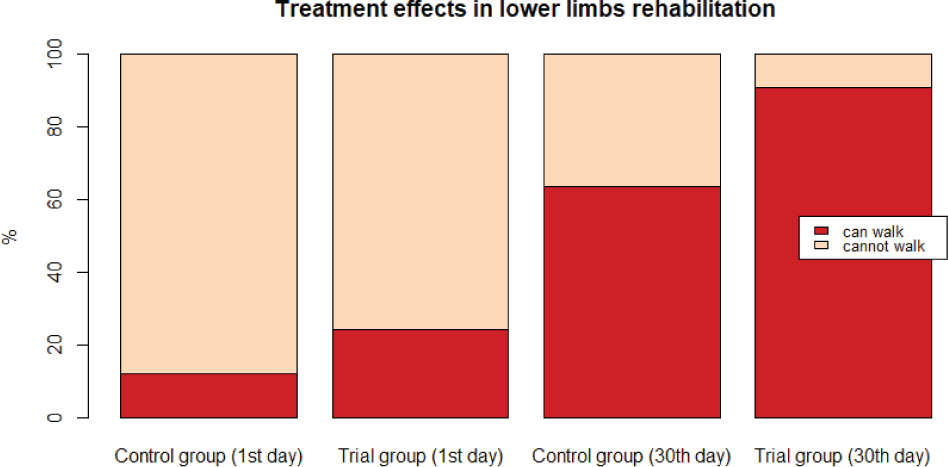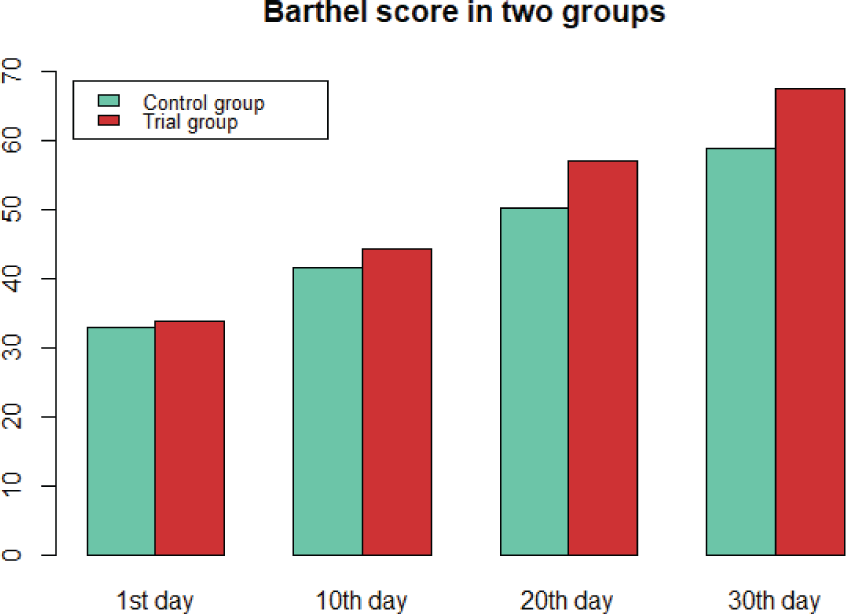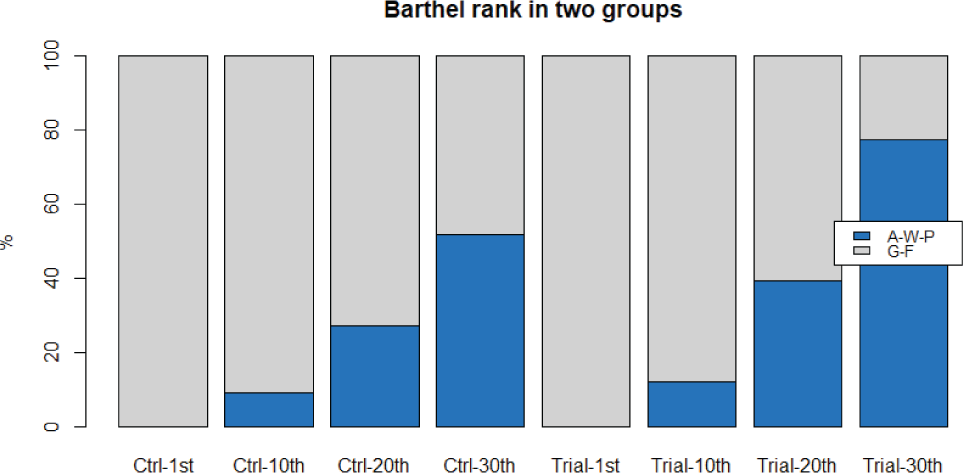1. INTRODUCTION
According to the World Health Organization, 15 million people suff stroke worldwide each year. Within this number, five million die and another five million are permanently disabled [12]. In Vietnam, about 200,000 stroke patients are recorded per year, in which 51.9% suff from the motor deficit [6]. The combination of modern medicine and traditional medicine in the rehabilitation of motor deficit after stroke has shown interesting results. Many studies on modifi acupuncture, a combination of modern and traditional techniques, have proven its effectiveness in motor rehabilitation in post-stroke patients [10, 11]. Modifi acupuncture is quite similar to neuromuscular electrical stimulation. However, the neuromuscular electrical stimulation does not perform percutaneously; therefore, it is difficult to aff the inner muscles and contract selective muscles. Furthermore, many studies have elucidated the effectiveness of the motor relearning method in the treatment of post-stroke paralysis [3, 5]. Therefore, this study aims to determine whether the combination of modifi acupuncture and motor relearning method can improve the treatment results.
2. METHOD
Our study was a multicenter randomized controlled trial conducting on 66 post-stroke patients at Traditional Medicine Hospital of Ho Chi Minh City, General Hospital of Soc Trang Province, and People Military Hospital of Soc Trang Province from July 2014 to July 2015. This study was approved by Ethics Board in Biomedical Research at University of Medicine and Pharmacy at Ho Chi Minh City.
The inclusion criteria were: the patients had to be fully aware and cooperative, their Barthel scores were ≤ 60 and they agreed to participate in the research. Stroke patients with ulceration, inflammation or cachexia due to lengthy lying on bed, or those who had complicated changes that needed other treatments during the research process were excluded.
The follwing variables were collected: Barthel score, Barthel rank, 10-hole test in one minute and three minutes for upper limbs, the ability to walk for lower limbs. patients were divided into two group randomly by Graphpad Software. The control group received modifed acupuncture and the Bobath method, which where current methods using in the researched hospitals, while the trial group received modified acupuncture and motor relearning program.
Modified acupuncture comprised three steps. Step one: Identifying weak or paralyzed muscles. Step two: Three pairs of acupoints were selected on both ends of the weak or paralyzed muscles, three pairs on the upper limb and three pairs on the lower limb. Step three: patients were given electro-acupuncture in 20 minutes. This process was conducted 1 time/day from Monday to friday until finishing 30 days of treatment.
Patients in the control group did exercises with 4 different positions including lying position (rolling onto paralyzed slide, rolling onto healed side, exercising paralyzed arm, paralyzed leg, paralyzed shoulder, and putting weight on leg, etc.), sitting position (sitting up, balancing while sitting, moving with buttocks, moving from bed to chair, controlling torso, exercising arm, and exercising leg), standing position (putting weight on non-paralyzed leg, putting weight on paralyzed leg, and exercising torso), and walking exercise [9].
Patients in the trial group did 4 specific tasks, including balancing, walking, standing up-sitting down, and reaching-manipulation. In each task, the exercises were conducted based on patients’ ability and performance. Every day, patients did the four exercises at least once, and the tasks were repeated based on the patients health status. Before exercising, patients were checked for vital signs. If the blood pressure was higher than 140/90 mmHg, they would not exercise that day [1, 2].
Every 10 days of treatment, patients were checked for vital signs, such as Barthel score, Barthel rank, were tested the ability to walk, and did the 10-hole test in one and three minutes.
Data were processed by Microsoft Excel 2007, and analyzed by STATA 10.0. We used the chi-square test to compare the patients’ status before treatment, to compare the ability to walk between two groups before and after treatment. The t-test was used to compare the treatment effects in upper limbs rehabilitation per 1 minute and 3 minutes, the Barthel score in each period of time between two groups and paired t-test was used to compare the treatment effects in upper limbs rehabilitation per 1 minute and 3 minutes, the Barthel score before and after treatment in each group.
3. RESULTS AND DISCUSSION
There was no statistically significant difference between the two groups in population traits, stroke histories, and accompanying diseases (Table 1 and Table 2).
Concerning upper limbs rehabilitation, both groups showed good results after treatment. The rings when doing the 10-hole test in one and three minutes of both groups were increased signifi (P < 0.0001). However, there was no statistically signifi diff between the two groups (P > 0.05) (Table 3, Figure 1, and Figure 2).

Concerning upper limbs rehabilitation, both groups showed good results after treatment. The rings when doing the 10-hole test in one and three minutes of both groups were increased significantly (P < 0.0001). However, there was no statistically significant difference between the two groups (P > 0.05) (Table 3, Figure 1, and Figure 2).
Concerning lower limbs rehabilitation, both groups showed good results after treatment. The patients’ walking competencies of both groups were increased significantly (P < 0.05). However, the trial group showed statistically significantly better results in lower limbs rehabilitation than the control group after 30 days of treatment (P < 0.05) (Table 4, Figure 3).
| Control group | Trial group | P value | |||
|---|---|---|---|---|---|
| No | % | No. | % | ||
| 1st day | |||||
| can walk | 4 | 12.12 | 8 | 24.24 | 0.202 |
| cannot walk | 29 | 87.88 | 25 | 75.76 | |
| 30th day | |||||
| can walk | 21 | 63.64 | 30 | 90.91 | 0.017 |
| cannot walk | 12 | 36.36 | 3 | 9.09 | |

Concerning general rehabilitation after treatment, both groups showed good results (P < 0.0001). However, the trial group showed statistically different better results in general rehabilitation than the control group after 30 days of treatment (P < 0.05). The total patients’ score and the patients’ rate in Good-Fair rank were increased significantly (P < 0.0001) (Table 5, Figure 4, and Figure 5).


Both treatments of the two groups took advantages of modified acupuncture. Modified acupuncture does not apply only traditional medicine’s theory (all acupoints selected were on the injured meridians as the acupoints on paralyzed limbs were used), but also modern medicine’s theory (all acupoints selected were on both ends of the weak or paralyzed muscles for better muscles contraction). Moreover, modified acupuncture applies electrical therapy by low-frequency electrical stimulation which can help rehabilitate the weak or paralyzed muscles. Last but not least, modified acupuncture also applies the neurobiology`s theory; as once proprioceptive sensory inputted in muscles are stimulated, it can stimulate both the sensory and the motor cortex [8, 11].
The Bobath method had two main purposes: spasticity prevention and rehabilitation of voluntary motor function in the paralyzed side. As a result, all exercises were focused on decreasing joint stiffness and enhancing muscle strength. Besides, the exercises used for each patient were similar according to patients’ stage of disease and patients’ health status (passive exercises, partly active exercises or active exercises).
The motor relearning program had two main purposes: facilitating brain reorganization and functional recovery. This method helped patients actively rehabilitate with intensive exercises. It promoted both physical and mental activities, as well as skills acquisition. The exercises used for each patient were different. This method is based on: First, there is functional plasticity after stroke associated with task-oriented exercise; second, training in real-life tasks can be a stimulus to make more functional connections within the remaining brain tissue and to form new synapses [1].
The reason why the trial group showed better results than the control group can be explained in two ways. In one way, in the control group, only one method supported brain reorganization while both methods in the trial group could facilitate brain reorganization. This opinion was also proven in many researches which stated that the combination of physical therapy and mental exercise was good for motor rehabilitation. In the other way, in the trial group, patients did specific tasks in real life with a real object. When performing a concrete task involved meaningful interactions with an object, patients demonstrated superior motor performance compared to an abstract task with no object involved [1].

